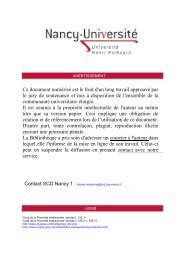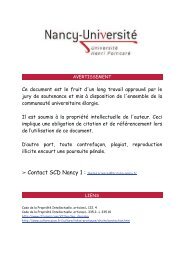Ce document numérisé est le fruit d'un long travail approuvé par le ...
Ce document numérisé est le fruit d'un long travail approuvé par le ...
Ce document numérisé est le fruit d'un long travail approuvé par le ...
You also want an ePaper? Increase the reach of your titles
YUMPU automatically turns print PDFs into web optimized ePapers that Google loves.
• 'i.<br />
156<br />
APC gene [154]. The APC protein takes place<br />
in the Wnt/ f3-catenin signalling pathway<br />
[157]. APC and f3-catenin are phosphorylated<br />
by glycogen synthase kinase 313 ; this process<br />
<strong>le</strong>ads to degradation of f3-catenin in a<br />
proteasome-dependent manner. In colorectal<br />
cancers, mutations affect the APC gene<br />
resulting in f3-catenin stabilisation and 13<br />
catenin translocation into nuC<strong>le</strong>us [158].<br />
Subsequently, f3-catenin interacts with<br />
members of the T-<strong>Ce</strong>ll tians~ription factors<br />
family (TCF, [159]) and alters transcription of<br />
TCF-dependent target genes like c-myc [160],<br />
cyclin Dl [161], cyclooxygenase-2 [162], c<br />
jun, fra-l and urokinase-type plasminogen<br />
activator receptor [163] which are implicated<br />
in céIl cyc<strong>le</strong> progression, cell proliferation<br />
and apoptosis and in cell to cell interactions.<br />
In colon cancers, ppARù transcription 1evel is<br />
up-regulated and seems to co-localise with<br />
cyclooxygenase-2 rnRNA in the same regions<br />
within the turnors [164]. ppARù has been<br />
identified ,as a target gene of Tcf4, a member<br />
of the TCF family [165]. Transfection of the<br />
comp<strong>le</strong>te APC gene in a APC-mutated colon<br />
cell line, the HT29 cell line, r<strong>est</strong>ores<br />
cytoplasmic f3-catenin degradation mediated<br />
by APC and subsequently lowers ppARf3<br />
transcriptional <strong>le</strong>vel. In addition, NSAIDs<br />
treatment decreases ppARù transcriptional<br />
activity <strong>le</strong>ading to the hypothesis that NSAIDs<br />
protection is mediated by disruption in<br />
ppARù-dependent target gene expression<br />
[165]. ,<br />
PPARyhas also been associated to colon<br />
cancers. The two isoforms exist even though<br />
PPARy1 is predominant [166]. However,<br />
different studies provide opposite results :<br />
Activation of PPARy by specific ligands is<br />
responsib<strong>le</strong> for tumor progression in APC/Min<br />
mice or heterozygote ma<strong>le</strong>s C57Bl/6J<br />
APCMin/+ [167, 168]. In contrast, in human<br />
colon cancer cell lines, activation of PPARy<br />
slows down their growth and consequently<br />
inhibits expression of tumor markers and<br />
increases transcription of proteins associated<br />
with colon cell differentiation [169]. In<br />
addition, development of transplantab<strong>le</strong><br />
Hervé Schohn et al.<br />
turnors in nude mice is lowered by treatment<br />
with troglitazone, a PPARy ligand [168].<br />
Thus, the ro<strong>le</strong> ofppARy in colorectal cancers<br />
is speculative despite its high transcriptional<br />
<strong>le</strong>vel. Furthennore, loss-of-function mutations<br />
also affect PPARy gene in human sporadic<br />
carcinomas altering protein function as<br />
demonstrated by transfection studies [170].<br />
In contrast to PPARf3/Ù and y, PPARa is not<br />
up-regulated [171]. !ts expression in tumoral<br />
cells is often lower than in normal tissue.<br />
PPARyin others neoplasic processes<br />
As stated before, thiazolidinediones are<br />
agonists of PPARy. These drugs and 15<br />
deoxy-ô-12, 14 prostaglandin 12, a natural<br />
ppARy ligand, have been used to study the<br />
ro<strong>le</strong> of ppARy activation in diverse cancerderived<br />
cell lines in vitro. Taken together,<br />
results show that ppARy activation induces<br />
cell cyc<strong>le</strong> arr<strong>est</strong> and terminal differentiation<br />
and/or apoptosis in malignant astrocytoma cell<br />
line [172], in choriocarcinoma cells [173], in<br />
human breast cancer cells [174-177], in<br />
human gastric cancer [178-180], in pancreatic<br />
carcinoma cells [181], in colon<br />
adenocarcinoma ceIls [166, 169, 182, 183], in<br />
lung cancer cells [184, 185], in myeloid<br />
<strong>le</strong>ukemia ceIl lines [186, 187], in human<br />
prostate cancer ceIls [188] and in liposarcoma<br />
ceIls [189]. Thus, it appears c<strong>le</strong>arly from these<br />
data that activation of ppARy has a benejic<br />
effect by limiting cancer cell growth.<br />
Moreover, terminal differentiation mediated<br />
by PPARy agémists was confmned in vivo in<br />
patients with liposarcoma [190] or prostate<br />
cancer [191] and in mice with prostate cancer<br />
[188] or mammary cancer [174, 192]. On the<br />
other hand, PPARy is upregulated in human<br />
uterine <strong>le</strong>iomyomata, benign tumors of<br />
smooth musc<strong>le</strong> ceIls, com<strong>par</strong>ed with nonnal<br />
myometrium [193].Further more, in guinea<br />
pig, troglitazone treatment combined with<br />
<strong>est</strong>radiol and aH trans retinoic acid produced<br />
uterine <strong>le</strong>iomyomata whereas this ppARy<br />
effect is not observed when troglitazone is<br />
used alone [193].Taken together, data sugg<strong>est</strong>
















